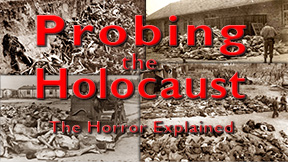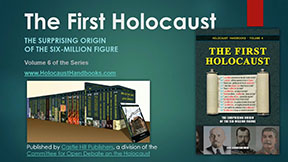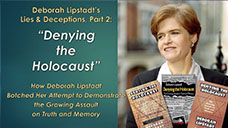An Introduction
The Contemporary Issue
Is asking questions a crime? If you develop doubts about the Holocaust, isn’t the only way to get rid of these doubts by asking questions? A lot of individuals and groups are enraged by those who ask critical questions about the Holocaust.
Every other historical issue is debated as a matter of course, but influential pressure groups have made the Holocaust story an exception. Anyone should be encouraged to investigate critically the Holocaust narrative in the same way they are encouraged to investigate every other historical event. This is not a radical point of view. It is just plain reason.
THE HISTORICAL ISSUE
National Socialists saw Jews as being an influential force behind international communism and finance. During World War II, Jews were considered to be enemies of the German State and a potential danger to its war efforts, much like the Germans, Italians, and Japanese were viewed in the U.S. Consequently, Jews were stripped of their rights, forced to live in ghettos, conscripted for labor, deprived of their property, deported, and otherwise mistreated. Many tragically perished.
In contrast to establishment historians, revisionists claim that the German State had NO policy to exterminate the Jewish people (or anyone else) in homicidal gas chambers or by killing them through abuse or neglect. Revisionists also maintain that the figure of six million Jewish deaths is an irresponsible exaggeration, and that no execution gas chambers existed in any camp in Europe which was under German control. Fumigation gas chambers, both stationary and mobile, did exist to delouse clothing and equipment in order to prevent disease at POW, labor, and concentration camps and at the fighting front. It is highly likely that it was from this life-saving procedure that the myth of extermination gas chambers emerged.
Revisionists generally hold that the Allied governments, and in particular the Soviets, decided to carry their wartime “black propaganda” of German monstrosities over into the postwar period. This was done for essentially three reasons. 1. The Allies felt it necessary to continue to justify the great sacrifices that were made in fighting two world wars. 2. The Allies wanted to divert attention from their own crimes against humanity. Soviet atrocities caused the death of millions in eastern and central Europe. American and British saturation bombings causing over a million civilians to be burned alive. 3. The Allies needed justification for their postwar dismantling of German industry, a policy of starvation causing the deaths of millions of Germans, and the annexation of large parts of Germany into Poland and the USSR (20% of the entire German territory). Twelve million Germans were brutally expelled. More than two millions perished.
Today, the Holocaust story, which is perceived as a crime of a right-wing regime, plays an important role for leftist-internationalist groups, for Zionist organizations, and for groups within Jewish communities. It is the leaders of these political and propaganda organizations who continue to work to sustain the orthodox Holocaust narrative and the myth of German monstrosity.
For those who believe that the Nuremberg Trials revealed the truth about German war crimes, it is a terrible shock to discover that then Chief Justice of the U.S. Supreme Court Harlan Fiske Stone described the Nuremberg court as “a high-grade lynching party for Germans.”
The Photographs
We’ve all seen “The Photographs,” especially the awful scenes at Dachau, Buchenwald, and Bergen-Belsen camps. But even mainstream historians admit that there was no German policy at any of those camps to kill the internees. In the last months of the war, while Soviet armies were invading Germany from the east, British and U.S. bombers were destroying every major city in Germany with saturation bombing. Transportation, the food distribution system, medical, and sanitation services all broke down. That was the purpose of these air raids, which was the most barbaric form of warfare in Europe since the Mongol invasion.
Millions of refugees fleeing the Soviet armies were pouring into central and western Germany. As a result of the ongoing war, of starvation, and epidemics, millions of civilians were dying all over Germany. The camps were not exempted from this tragedy. By early 1945, these inmates suffered from malnutrition and epidemics like typhus and cholera, to which many succumbed. When the press entered the camps with British and U.S. soldiers, they found the results of that. They took “The Photographs.”
Still, at camps such as Buchenwald, Dachau, and Bergen-Belsen tens of thousands of relatively healthy internees were liberated. They were there in the camps when “The Photographs” were taken.
Documents
In response to challenges to show documents proving the Jewish genocide, only a handful of documents are produced, the authenticity or interpretation of which is highly questionable. If pressed for clear evidence, it is claimed that the Germans destroyed the documents to hide their evil deeds, or the absurd claim is made that the Germans used code language, whispered verbal orders, or conveyed orders through a meeting of minds.
All available evidence indicates that there was no order for a mass murder of Jews, no plan, no budget, no weapon—that is, no gas chamber—and no victim—that is, not a single autopsied body has been shown to have been gassed.
Eyewitness Testimony
During medieval witch trials, many witnesses told about broom-riding witches and the devil. Since most statements were made independently and without pressure, this was taken as evidence that the stories must be true; material evidence was never produced. “Common knowledge” and social pressure were the basis of these tales, not the truth.
Today we again face “common knowledge” produced by 70 years of one-sided mass-media propaganda and massive social and legal pressure. To support their theories, anti-revisionists depend almost exclusively on “eyewitness” testimony produced in this poisoned atmosphere.
During the war-crimes trials many “eyewitnesses” testified that Germans made soap out of human fat. For decades, highly respected scholars sanctioned these stories. But in 1990, Yehuda Bauer, director of Holocaust studies at Hebrew University, Jerusalem, admitted: “The Nazis never made soap from Jews…”
Bruno Baum, a former communist inmate in Auschwitz, was allowed to brag in summer 1945 in a Soviet newspaper: “The whole propaganda which started about Auschwitz abroad was initiated by us [German communist inmates] with the help of our Polish comrades.” During several post-war trials it emerged that the testimonies of witnesses from eastern Europe had been orchestrated by communist authorities.
The only two witnesses who were ever cross-examined had to admit in 1985 that their accounts were not true: Arnold Friedman confessed to never having experienced what he had claimed, and Rudolf Vrba, one of the most famous Auschwitz witnesses, admitted to having used poetic license to “embellish” his statements. Once asked by a fellow survivor if all his claims were true, Vrba replied: “I do not know. I was just an actor and I recited my text.”
During and after the war there were “eyewitnesses” to mass gassings at Buchenwald, Bergen-Belsen, Dachau, and other camps in Germany proper. Today, virtually all recognized scholars dismiss this testimony as false.
Establishment historians, however, still claim that mass gassings happened at several camps in Poland. But the evidence for this is of the same nature as the evidence falsely claiming mass gassings in other camps in Germany.
With regard to confessions by Germans at war-crimes trials, it is now well documented that many of the earlier testimonies were obtained through coercion, intimidation, and even physical torture, just like during the medieval witch trials.
Auschwitz
In 1990, the Auschwitz State Museum revised the old propaganda claim of four million murdered humans down to one million—based not upon facts, but upon estimates! In 1994, a French scholar reduced this figure further down to less than 700,000, and in 2002, another mainstream Holocaust scholar reduced the Auschwitz death toll to 500,000—again not based on facts, but on “estimates.”
The Auschwitz Museum has put on display piles of hair, boots, and eyeglasses, etc., but there is neither evidence for the origin of these items nor for the fate of their former owners. While such displays are effective propaganda, they are worthless as historical evidence.
In a videotaped interview, the Auschwitz Museum authorities admitted that the gas chamber shown to tourists is a “reconstruction,” again not based on facts, but only on eyewitness claims, which contradict wartime documents. The museum guides, however, have told visitors for decades that all that they see is genuine…
Whereas some mainstream scholars claim that the Auschwitz crematories, whose morgues supposedly served as gas chambers, were the “absolute center” in the “geography of atrocities,” other mainstream scholars claim that the mass murder did not take place in those crematories, but elsewhere. Revisionists, however, want certainty, not speculations and estimates.
Majdanek
When the Soviets captured the Majdanek Camp near Lublin, Poland, in 1944, they claimed that 2 million inmates were killed there in seven gas chambers. Shortly after the war, Polish researchers reduced the death toll to some 360,000. After the collapse of the Soviet Union, that number went down to 235,000, and in 2005, the Majdanek Museum reduced it further to 78,000, with only a few of them being victims of now merely two gas chambers. So what is with the other 1,922,000 victims and with the other five gas chambers? Were they errors or lies? And why should anyone believe what they tell us now? If they were that terribly wrong here, where else are they wrong?
Jewish Population Losses during World War II
Two monographs were written on the question of Jewish losses during World War II. The first concluded that some 300,000 perished. The second claimed that some six million died. Whereas the first book takes into consideration demographic changes of the Jewish population in all countries, the second book compiles its figures by simply subtracting the number of Jews alive in Europe a few years after the war from those alive in Europe several years before the war. It ignores that the Jewish population in America, Israel, and other countries outside of Europe had increased by almost six million in this period of time, as a result of a new Exodus. Thus, those who had left Europe were simply declared to be Holocaust victims.
The Hidden Genocide
It is true that during WWII, the world responded with indifference to what happened to the Jews. But it is also certain that if there had been “killing factories” in Poland murdering millions of civilians, then the Red Cross, the pope, humanitarian agencies, the Allied governments, neutral governments, and prominent figures such as Roosevelt, de Gaulle, Truman, Churchill, Eisenhower, and many others would have known about it and would have often and unambiguously mentioned it, and condemned it. They did not! Not even in their autobiographies and war memoirs!
Examples of Propaganda
Starting in the late 1800s, and climaxing during and after the First(!) World War, mainly American Jewish organizations were claiming that six million Jews(!) would suffer terribly in Eastern Europe, even stating they were being exterminated in a holocaust. With such propaganda, millions of dollars were raised in the U.S., which at the end were mainly used to support the Soviet revolution in Russia.
On 22 March 1916, that is during the First World War, the British newspaper The Daily Telegraph published an article falsely claiming that the Germans had murdered 700,000 Serbs in gas chambers. On 25 May 1942, that is during the Second World War, the same newspaper reported that the Germans had murdered 700,000 Jews in Poland in gas chambers. In 1944, the British Government asked the British media and churches to help spread anti-German propaganda, which it had been putting out already for a while, in order to distract from the atrocities it expected to be committed by the Soviets as soon as they invaded Germany. In its circular, the British government expressed its regret that, after the exposure of WWI propaganda lies, greater efforts would be necessary to make people believe it.
POLITICAL CORRECTNESS AND REVISIONISM
Many people are bewildered when they first hear Holocaust revisionist arguments. The arguments appear to make sense, but “How is it possible?” After all, the whole world believes the orthodox Holocaust narrative. It’s just not plausible that the truth could have been suppressed for so many decades.
To understand how it could have happened, one needs only to reflect on the intellectual and political dogmas of medieval Europe, of National Socialist Germany, or of the Communist-bloc countries. In these societies, the great majority of scholars were caught up in the existing political culture. Committed to a prevailing ideology, these scholars and intellectuals felt it was their right and duty to protect that ideology. They did so by oppressing “evil” dissidents who expressed “offensive” or “dangerous” ideas. In those societies, scholars became the “Thought Police.”
In our own society, in the debate over the question of political correctness, there are those who deliberately attempt to trivialize the issues. They claim that there is no real problem with freedom of speech in our society, and that all that is involved with political correctness are a few rules which allegedly protect minorities from those who would otherwise hurt their feelings. There is, of course, a more serious aspect to the problem. In American society today, there is a wide range of ideas and viewpoints which the mass media will not allow to be discussed openly. Even obvious facts and realities, when they are politically unacceptable, are denied and suppressed. One can learn much about the psychology and methods of the Thought Police by watching how they react when just one of their taboos is broken, and Holocaust revisionism is given a public forum.
First they express outrage that such “offensive” and “dangerous” ideas were allowed to be expressed publicly. They avoid answering or debating these ideas, claiming that to do so would give the revisionists a forum and legitimacy. Then they make vicious personal attacks against the revisionist heretics, calling them political names such as “hater” or “denier,” even suggesting that they are potential mass murderers. They publicly accuse the revisionists of lying, but they don’t allow these dissidents to face their accusers so that they can answer this slander.
Revisionists are frequently accused of being hate-filled people who are promoting a doctrine of hatred. But revisionism is a scholarly process, not a doctrine or an ideology. If the Holocaust promoters really want to expose hatred, they should take a second look at their own doctrines, and a long look at themselves in the mirror.
Anyone who invites a revisionist to speak publicly is himself attacked for being insensitive. When revisionists do speak publicly, they are regularly shouted down and threatened. Libraries and bookstores such as Amazon face threats and intimidation when they offer Holocaust revisionist materials. All this goes on while the majority of library, media, college, and university administrators stand silently by, allowing political activists to determine what can be said in the media and read in libraries.
Next, the Thought Police set out to destroy the transgressors professionally and financially by “getting” them at their jobs or concocting lawsuits against them. It is sometimes often deceptively claimed that revisionist scholarship has been proven false during a trial, though courts of law can never decide any scholarly debates; they can only impose dogmas.
Finally, the Thought Police will inevitably “straighten out” that segment of academia or the media that allowed the revisionists a forum in the first place.
Some administrators in academia hold that university administrations should take action to rid the campus of ideas which are disruptive. This is an open invitation to tyranny. It means that any militant group with “troops at the ready” can rid the campus of ideas it opposes. Timorous administrators might find it much easier and safer to rid the campus of controversial ideas than to face down a group of screaming militants. But it is the duty of university administrators to insure that our universities remain a free marketplace of ideas. When ideas cause disruptions, it is the disrupters who must be subdued, not the ideas.
CONCLUSION
The influence of Holocaust revisionism is growing steadily both here and abroad. In the United States, revisionism was launched in earnest in 1976 with the publication of the book The Hoax of the Twentieth Century by Prof. Dr. Arthur R. Butz. Today, revisionism is presented in many university-style studies of serious scholarship. Those who take up the revisionist cause, represent a wide spectrum of political and philosophical positions. They are certainly not the scoundrels, liars and demons the anti-revisionists try to make them out to be. The fact is, there are no demons in the real world. People are at their worst when they begin to see their opponents as an embodiment of evil, and then begin to demonize them. Such people are quite prepared to harm their opponents. The logic of their argument is that you can do anything you want to a demon. We should not allow such a logic to prevail.
Those wishing to verify the truthfulness of the statements made here are invited to visit our website www.HolocaustHandbooks.com where you can watch thoroughly researched documentaries and download free of charge most of our 52 meticulously documented studies on various aspects of the Holocaust (as of February 2024).
Download this leaflet for free in legal size for free printing, copying, distribution.
Committee for Open Debate on the Holocaust
www.CODOH.com
www.HolocaustHandbooks.com
The above text is a revised version of a 1991 leaflet which was written by Bradley Smith and M. Sarich of Chicago. I revised the text in 2003 and published it again as a leaflet distributed until my arrest and deportation from the U.S. in 2005. Currently, no hard copy of it is available. But I’m sure you can download the PDF file and use it to print your own hard copy. The text is in the public domain, with nobody overly eager to see his/her copyright protected. (I’ve also updated some links here.)






